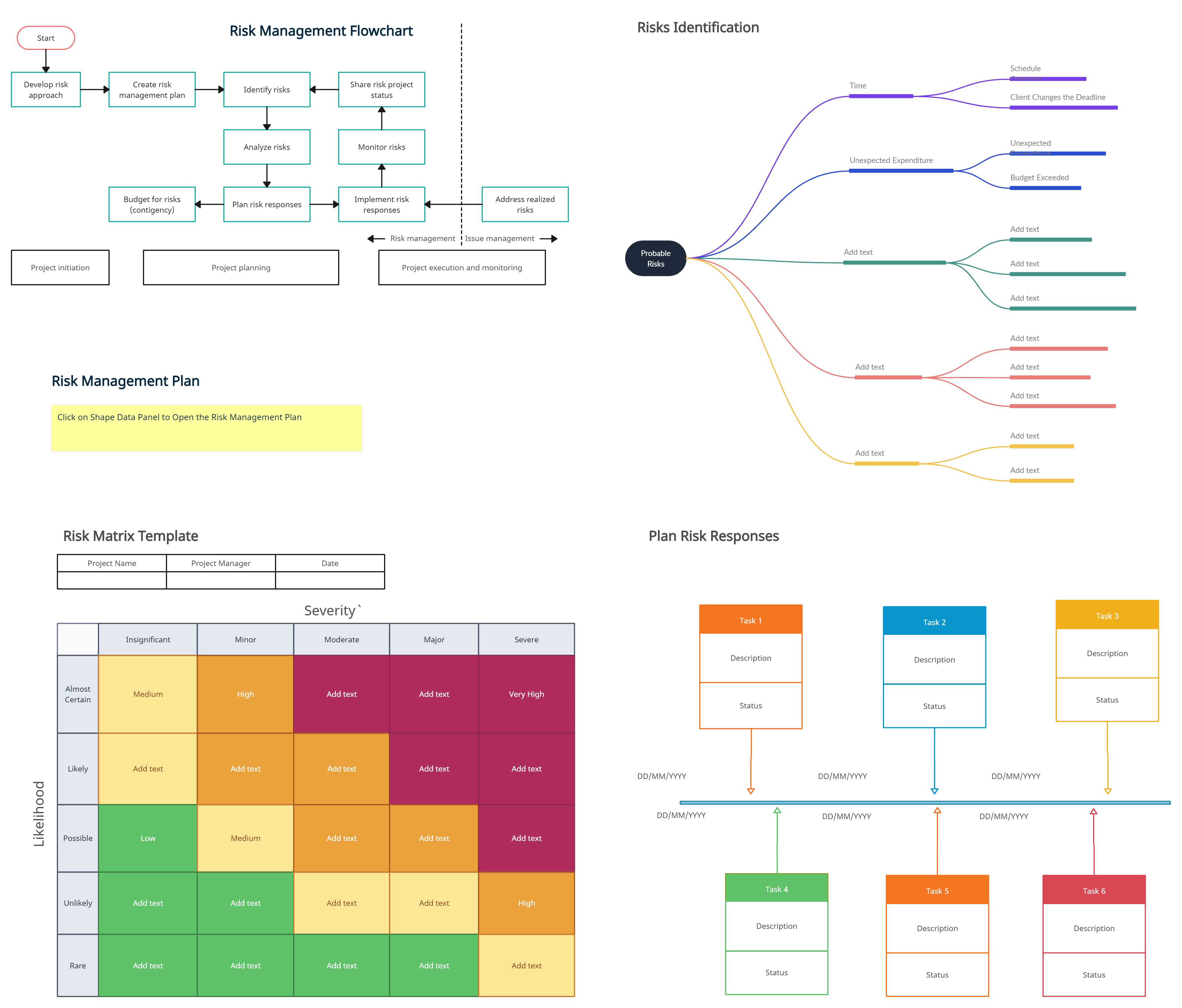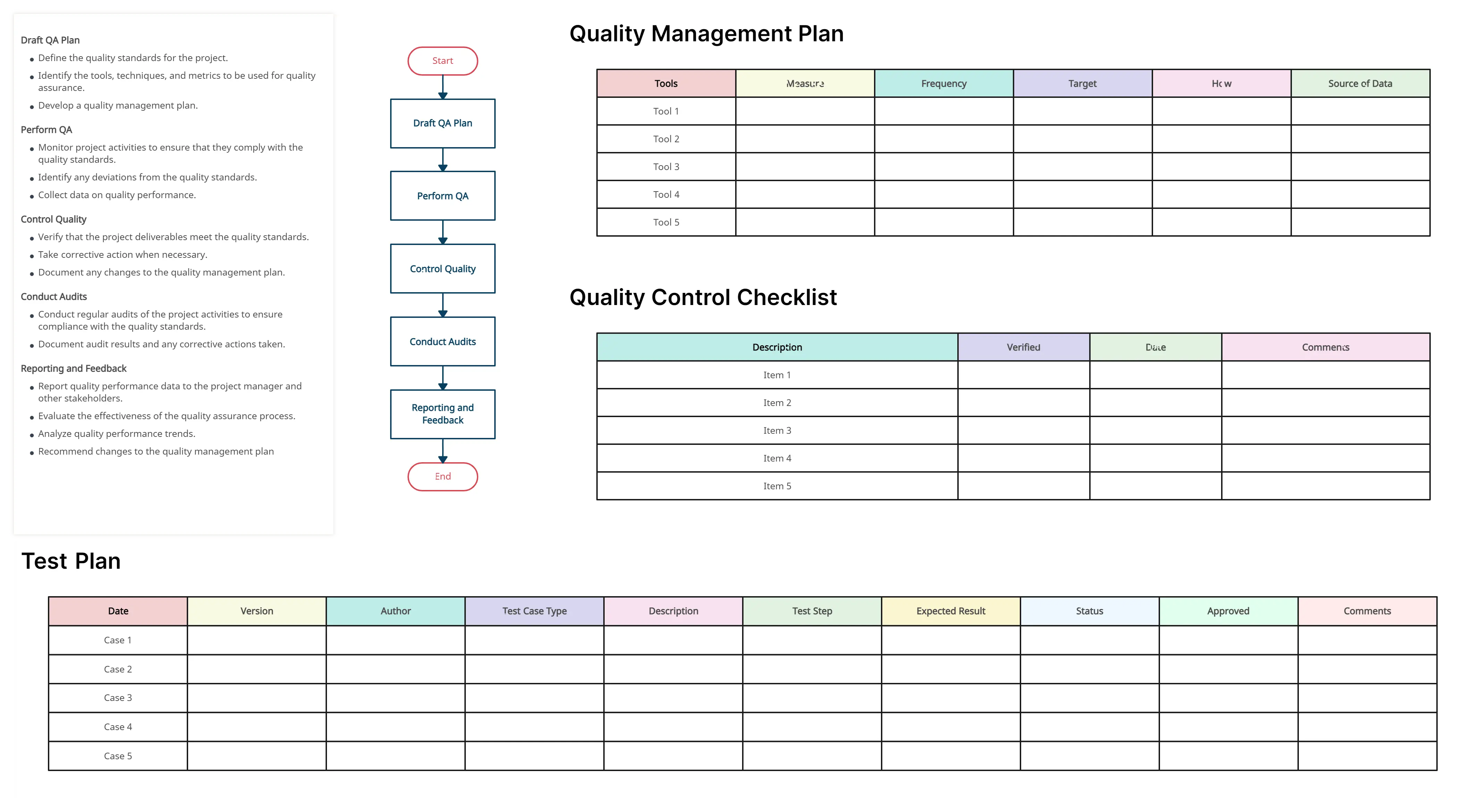Successful project delivery requires effective risk and quality management. To achieve this, project managers can utilize specialized tools such as Risk Management Plan Templates and Quality Management Plan Templates. These workspaces provide a structured approach to identify, assess, and mitigate potential risks, as well as establish and maintain quality objectives throughout the project lifecycle.
In this article, we will discuss the benefits of using these templates and provide practical examples to help project managers implement them effectively. By utilizing these tools, project managers can improve their ability to deliver successful projects that meet stakeholder expectations.
Whether you are a seasoned project manager or just starting in your role, this comprehensive guide will provide editable templates and valuable insights on how to effectively manage risk and quality for project success.
Risk Management Plan Template:
Risk management is an integral part of project management, and project managers need specialized tools to manage risk effectively. The risk management plan template is a dedicated tool that provides project managers with all the templates and resources they need to manage project risks successfully.
The risk management plan template typically includes a range of tools and resources, such as risk identification templates, risk assessment matrices, and risk mitigation plans. These tools help project managers identify, assess, and mitigate risks throughout the project lifecycle. This helps project managers to stay ahead of potential issues and to deliver successful projects on time and within budget.
The risk identification template
The risk identification template helps project managers identify potential risks that could affect the project’s success. These templates are designed to prompt project managers to think about all possible risks, both internal and external, that could impact the project’s success. The templates help project managers to develop a comprehensive list of risks that can be assessed and prioritized.The risk assessment matrix
The risk assessment matrix is a tool that helps project managers evaluate the likelihood and impact of each identified risk. The matrix helps project managers to prioritize risks based on their potential impact on the project and to develop risk mitigation plans accordingly.The risk mitigation plan
The risk mitigation plan is a critical component of the risk management plan template. This plan outlines the strategies and actions that project managers will take to mitigate identified risks. The plan includes details such as who will be responsible for implementing specific actions, timelines, and metrics for measuring the effectiveness of the risk mitigation strategies.
In practice, the following risk management plan template can be used to manage risks in a range of projects, from large-scale construction projects to small software development projects. It is flexible and can be adapted to suit the needs of each project.

Interesting read: Writing a Successful Crisis Management Plan: 9 Essential Steps to Follow
In the next section, we’ll explore the quality management plan template and how it can help project managers to manage project quality effectively.
Quality Management Plan Template:
Quality management is a crucial aspect of project management, and project managers require specialized tools to ensure that their projects meet the desired quality standards. The quality management plan template is a dedicated tool that provides project managers with all the necessary templates and resources to manage project quality successfully. With this workspace, project managers can identify quality issues, develop quality assurance plans, and monitor and control quality throughout the project lifecycle.
The quality management plan template typically includes a range of tools, templates, and resources, such as quality control checklists, process improvement templates, and performance metrics dashboards. These tools help project managers to ensure that the project meets the required quality standards and that stakeholder expectations are met.
Quality control checklist
The quality control checklist is a tool that helps project managers to ensure that all project deliverables meet the required quality standards. The checklist includes a list of criteria that project managers can use to evaluate each deliverable, ensuring that it meets the project’s quality standards. By using a quality control checklist, project managers can ensure that project deliverables are of high quality and meet stakeholder expectations.Process improvement templates
Process improvement templates are tools that help project managers to identify and improve inefficient or ineffective project processes. The templates provide project managers with a structured approach to process improvement, enabling them to identify areas for improvement and to implement changes effectively. By using process improvement templates, project managers can ensure that the project is running efficiently and effectively.Performance metrics dashboard
The performance metrics dashboard is a tool that helps project managers to track and monitor project performance against predefined metrics. The dashboard provides project managers with real-time information on project performance, enabling them to identify potential issues and take corrective action quickly. By using a performance metrics dashboard, project managers can ensure that the project is on track to meet its objectives and that stakeholder expectations are being met.
In practice, the quality management plan template can be used to manage quality in a range of projects, from product development to service delivery projects. The workspace is flexible and can be adapted to suit the needs of each project.
At Creately, we understand the importance of managing quality effectively in project management. That’s why we have developed a specialized quality management plan template that is tailored to meet project managers’ specific needs. Our quality management plan template includes all the necessary tools, templates, and resources that project managers need to manage quality effectively and efficiently.

Benefits of Using Premade Templates:
Creately’s centralized workspaces for risk management planning and quality management planning can provide project managers with a range of benefits that can help them to manage their projects more efficiently and effectively. In this section, we will explore the benefits of using specialized workspaces in more detail.
Improved Efficiency
One of the primary benefits of using these specialized workspaces is that they can improve efficiency. They provide project managers with all the tools and resources they need in one place, which eliminates the need for them to search for the tools they need. This can save project managers a significant amount of time, allowing them to focus on more critical tasks and improve their productivity.
Better Risk Management
They can also help project managers to manage risk more effectively. The risk management plan template provides project managers with all the tools they need to identify, assess, and mitigate risks. By having a dedicated risk management plan template, project managers can ensure that they are proactive in managing risks, which can reduce the likelihood of project delays and failures.
Enhanced Quality Management
These premade templates can also help project managers to manage quality more effectively. The quality management plan template provides project managers with all the tools they need to manage quality effectively. By using a dedicated quality management plan template, project managers can ensure that project deliverables meet the required quality standards and that stakeholder expectations are met.
Improved Collaboration
Collaboration is an essential aspect of project management, and centralized workspaces can facilitate collaboration among team members. By having all the project tools and resources in one place, team members can work more effectively together, sharing information and collaborating on tasks. This can help to improve team morale and productivity, which can ultimately lead to better project outcomes.
Increased Visibility
They can also provide project managers with increased visibility into project performance. By using tools such as performance metrics dashboards, project managers can monitor project progress and identify potential issues quickly. This can help project managers to take corrective action before issues escalate, reducing the likelihood of project delays and failures.
Standardization
Standardization is crucial for project management, and these workspaces can help project managers to standardize project processes. By providing project managers with a set of standardized tools and resources, project managers can ensure that all team members are following the same procedures. This can help to improve project efficiency and reduce the likelihood of errors or inconsistencies.
Implementing Specialized Workspaces:
To implement these workspaces successfully, project managers need to follow a few key steps.
Identify the Requirements
The first step is to identify the requirements. Project managers need to understand the project’s specific needs, such as the type of risks and quality standards that need to be managed. By identifying these requirements, project managers can ensure that the templates are tailored to their project’s needs.
Define the Processes
Defining the processes involves identifying the steps that team members need to follow when using the workspaces. Project managers need to ensure that the processes are standardized and that all team members are following the same procedures.
Train Team Members
Once the processes are defined, project managers need to train team members on how to use the workspaces effectively. Team members need to understand how to use the tools and processes and how to collaborate effectively using specialized workspaces.
Monitor and Evaluate
Finally, project managers need to monitor and evaluate the effectiveness of the implementation efforts continually. They need to track the progress of the project and identify any issues that arise. By monitoring and evaluating the specialized workspaces, project managers can identify areas for improvement and take corrective action as necessary.
Frequently Asked Questions (FAQs)
What is the importance of risk and quality management in project delivery?
Risk and quality management are crucial for successful project delivery. Effective management of risks and quality can help project managers to stay ahead of potential issues and to deliver successful projects on time and within budget while meeting stakeholder expectations.What specialized tools can project managers use to manage risk and quality effectively?
Project managers can utilize specialized tools such as Risk Management Plan Templates and Quality Management Plan Templates to manage risk and quality effectively. These workspaces provide a structured approach to identify, assess, and mitigate potential risks, as well as establish and maintain quality objectives throughout the project lifecycle.When can project managers use the risk identification template?
Project managers can use the risk identification template to identify potential risks that could affect the project’s success. These templates are designed to prompt project managers to think about all possible risks, both internal and external, that could impact the project’s success.How can project managers prioritize risks using the risk assessment matrix?
The risk assessment matrix helps project managers to evaluate the likelihood and impact of each identified risk. This matrix helps project managers to prioritize risks based on their potential impact on the project and to develop risk mitigation plans accordingly.Why is the risk mitigation plan a critical component of the risk management plan template?
The risk mitigation plan outlines the strategies and actions that project managers will take to mitigate identified risks. It includes details such as who will be responsible for implementing specific actions, timelines, and metrics for measuring the effectiveness of the risk mitigation strategies. The risk mitigation plan is critical because it helps project managers proactively manage risks and minimize their impact on the project.How can project managers ensure that project deliverables meet the required quality standards using the quality control checklist?
The quality control checklist is a tool that helps project managers to ensure that all project deliverables meet the required quality standards. The checklist includes a list of criteria that project managers can use to evaluate each deliverable, ensuring that it meets the project’s quality standards. By using a quality control checklist, project managers can ensure that project deliverables are of high quality and meet stakeholder expectations.
Conclusion
In conclusion, project managers face a variety of challenges when managing risk and quality in projects. However, using specialized templates can help project managers overcome these challenges and achieve better project outcomes. Creately’s specialized workspaces for risk management and quality management provide project managers with the necessary tools and processes to manage risks and maintain quality standards effectively.
Our workspaces come equipped with a range of features, such as visual collaboration tools, extensive diagramming capabilities, formatting options, notes, and more, allowing project managers to work efficiently and effectively. Our templates are easy to use and fully editable, ensuring that project managers can customize them to meet their specific needs.
So if you are a project manager looking to streamline your risk and quality management processes, we invite you to try out our specialized workspaces. With Creately, project managers can work smarter to deliver successful projects.
Sign up for Creately’s Risk Management, and Quality Management planning templates today, and take your project management skills to the next level!


![What is a Project Initiation Document (PID)? [with Free Template]](/static/assets/guides/project-initiation-document-explained/hero.webp)


